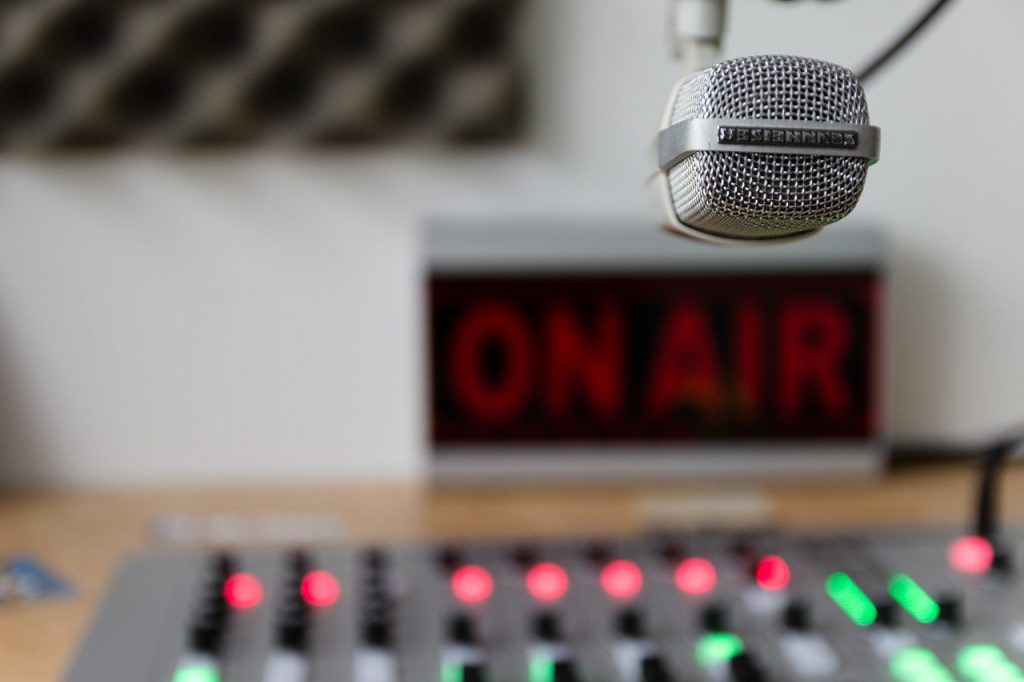Tune In to Broadcasting Vocabulary Posted by Gary Locke on May 28, 2020 in Culture, English Vocabulary
A long time ago, I was a disc jockey. In fact, I was a broadcaster on two different continents. It was an odd job because I could spend hours on the air playing music, reading news, announcing the time as it passed by on my shift, reading the occasional advertisement – never really being sure that anyone was listening to me. It can be a very solitary, lonely work.
I have some stories from those years. Oh, boy, do I have some stories! Like the time, in the middle of the night, when someone tried to climb through a window to make a request. Or the nice woman who baked me a pie and left it on the steps outside the studio. There were some pranks, too. Broadcasters tend to have a very off-center sense of humor.
With the job, there was also a very specific set of words and expressions which only others in the profession would know. Over the years, broadcasting has evolved, as has the glossary of terms associated with it. Here are some selected words and phrases that you may like to know if you ever want to sit behind a microphone.
- Amplitude Modulation – AM
A broadcast signal that varies the amplitude of the carrier wave. It is used by AM broadcast stations and requires an AM receiver. The AM frequency range is 530 to 1710 kHz.
- Back Announce
Talking about a song which has just played. If a disc jockey plays two or more songs in a row, the first one is introduced, then the following song or songs will be back announced.
- Back Time
Determining how much time a song can play before an event, such as a news announcement or a commercial.
- Bed
Music playing in the background while a broadcaster speaks.
- Bumper
A little bit of music that plays in transition to or from commercials or news breaks.
- Call Sign
Essentially, this is the name of the broadcasting station in the form of initials. East of the Mississippi, call signs begin with a “W.” West of the Mississippi, the signs begin with a “K.” Old stations have three letters, more recently licensed stations have four initials. All stations must identify themselves with their call signs near the top of every hour.
- Cue
Preparing a song to be played, or preparing a presenter to speak live on the air.
- Cue Light
The signal to go on the air, or to stop speaking. Green means go, red means stop.
- Dead-Air
Silence on the air during a broadcast. It’s a sure sign that something has gone wrong and is to be avoided at all costs.
- Demo Tape
Either a song which was sent in to promote a new singer or song, or a recording made by a presenter as an audition for a job.
- Digital Audio Workstation (DAW)
Audio editing software. This is the primary tool for a podcaster or a station’s audio engineer.
- Disc Jockey (DJ)
The person who plays music on a radio station.
- Drive Time
The parts of the day when most people are commuting, and thus most likely to be listening to the radio. Also known as the morning and afternoon rush hour.
- Frequency Modulation – FM
A broadcast using variation in the frequency of the carrier wave. Used by FM stations, the frequency range is 88 to 108 MHz
- Gain
The measure of the intensity of the signal into audio equipment, like microphones. Too much gain may cause distortion, making the sound difficult to hear. Not enough gain indicates a weak signal.
- HD Radio
Transmitting audio signals digitally, rather than through an AM or FM signal.
- Hit the Post
Talking over the Intro of a song right up to the point that the lyrics begin. Tricky, but a source of pride for the DJs who are good at it.
- Intro
The music which plays before the song’s lyrics.
- Media Host
The service providers where podcasts are found.
- Payola
Taking money to play songs over the air so that they become better known and popular. It’s illegal.
- Promo
An advertisement. This is how radio stations make their money.
- PSA
A public service announcement to promote an event or cause. No fee was paid to the station.
- Station Format
Every station emphasizes some type of format. Classical, classic rock, country, progressive rock, jazz, news, sports, talk – these are some of the most popular formats, but there are more. If you don’t like the format, change the station.
- Spot
Either a promo or a PSA.
- Tease
A brief comment, usually made before a commercial break, hinting at something the listener will hear in the near future.
- Total Reach
The estimated number of listeners to the station during a specific time period in the week.

Build vocabulary, practice pronunciation, and more with Transparent Language Online. Available anytime, anywhere, on any device.




